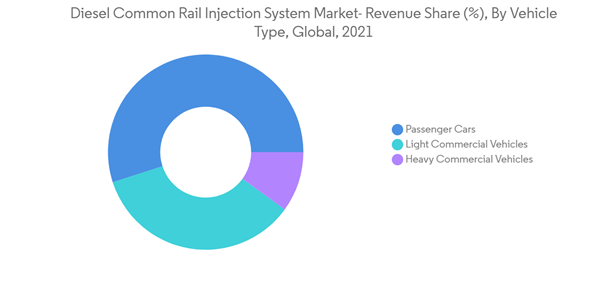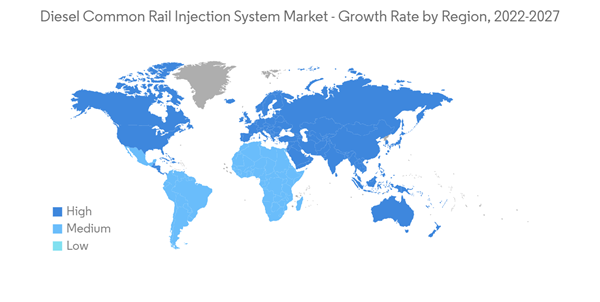The Diesel Common Rail Injection System Market was valued at USD 21.42 billion in 2021, and it is expected to reach USD 27.90 billion by 2027, registering a CAGR of about 4.5% during the forecast period (2022 - 2027).
COVID-19 negatively impacted the market. The COVID-19 pandemic saw a fall in economic growth in nearly all the major regions, thus altering consumer spending patterns. Due to the lockdown executed around several countries, international and national transport have been hampered, which has considerably affected the supply chain of several industries around the world, thus expanding the supply-demand gap. Therefore, failure in raw material supply is anticipated to hamper the production rate of diesel common rail injection systems, which negatively impacts the market growth.
Over the medium term, the rigorous emission norms being enforced by global governmental and environmental agencies are marked to be promoting the growth of the diesel common rail injection systems market. Also, the lower cost of diesel vehicles, as well as the lower cost of diesel in comparison with petrol, is also evenly stimulating the sales volumes of diesel automobiles, thus impacting the market growth. However, increasing demand and penetration of electric vehicles in the automotive sector are anticipated to hinder the market's growth. For instance,
It is estimated that Asia-pacific will dominate the diesel common rail injection system market, showing considerable growth during the forecast period. Middle-East and Africa is the fastest growing market in the region.
The automotive industry has recorded considerable growth in recent years, owing to the introduction of vehicles with efficient fuel consumption technology and technological advancements. Various companies such as Tata Motors and Ashok Leyland have been introducing and developing their advanced commercial vehicles to several global markets, which has enhanced the growth of the global market. For instance,
Geographically, Asia-Pacific is a prominent region in the CRDI market, followed by North America and Europe. The Asia-Pacific region is majorly driven by countries like China, Japan, and India. The region is expected to dominate the market as an automotive hub, owing to increasing vehicle production per year across several countries in this region during the forecast period. The demand for diesel common rail injection systems is growing in the country due to numerous factors, such as companies entering partnerships for developing new products and manufacturers investing in R&D projects. For instance,
The diesel common rail injection system market is consolidated, with the presence of major companies, such as Robert Bosch GmbH, DENSO Corporation, BorgWarner Inc., and Continental AG. The market also has the presence of other companies, such as Cummins. Robert Bosch is leading the market. The company produces the common rail system for gasoline and diesel engine systems under the powertrain category of the mobility solutions business division. The CRS2-25 and CRS3-27 models are the two common rail systems offered with solenoid and Piezo injectors. The company has a strong presence in Europe and America.
Continental AG holds the second position in the market. Earlier, Siemens VDO used to develop common rail systems for vehicles. However, it was later acquired by Continental AG, which is currently offering diesel common rail injection systems for vehicles under the powertrain division.
This product will be delivered within 2 business days.
COVID-19 negatively impacted the market. The COVID-19 pandemic saw a fall in economic growth in nearly all the major regions, thus altering consumer spending patterns. Due to the lockdown executed around several countries, international and national transport have been hampered, which has considerably affected the supply chain of several industries around the world, thus expanding the supply-demand gap. Therefore, failure in raw material supply is anticipated to hamper the production rate of diesel common rail injection systems, which negatively impacts the market growth.
Over the medium term, the rigorous emission norms being enforced by global governmental and environmental agencies are marked to be promoting the growth of the diesel common rail injection systems market. Also, the lower cost of diesel vehicles, as well as the lower cost of diesel in comparison with petrol, is also evenly stimulating the sales volumes of diesel automobiles, thus impacting the market growth. However, increasing demand and penetration of electric vehicles in the automotive sector are anticipated to hinder the market's growth. For instance,
- Bharat Stage (BS) norms aim at tighter regulations by reducing the permissible level of tailpipe pollutants. For example, BS-IV - introduced in 2017, allowed 50 parts per million (ppm) of sulfur, while the new and updated BS-VI - applicable from 2020, allows only 10 ppm of sulfur, 80 mg of NOx(Diesel), 4.5 mg/km of particulate matter, 170 mg/km of hydrocarbon and NOx together.
It is estimated that Asia-pacific will dominate the diesel common rail injection system market, showing considerable growth during the forecast period. Middle-East and Africa is the fastest growing market in the region.
Key Market Trends
Development of the Automotive Industry and Growing E-Commerce, Construction, and Logistics Activities Across Several Countries in the World.
The automotive industry has recorded considerable growth in recent years, owing to the introduction of vehicles with efficient fuel consumption technology and technological advancements. Various companies such as Tata Motors and Ashok Leyland have been introducing and developing their advanced commercial vehicles to several global markets, which has enhanced the growth of the global market. For instance,
- In November 2021, Tata motors has launched Tata Signa 3118. T, Tata Signa 4221. T, Tata Signa 4021. S, Tata Signa 5530. S 4×2, Tata Prima 2830. K RMC REPTO, Tata Signa 4625. S ESC a Medium And Heavy Commercial Vehicle Segment.
- In 2021, the size of the Indian logistics market was around USD 250 billion. It was estimated that this market would grow to USD 380 billion in 2025, at a compound annual growth rate between 10% to 12%.
Asia-Pacific likely to Exhibit the Highest Growth Rate during the Forecast Period
Geographically, Asia-Pacific is a prominent region in the CRDI market, followed by North America and Europe. The Asia-Pacific region is majorly driven by countries like China, Japan, and India. The region is expected to dominate the market as an automotive hub, owing to increasing vehicle production per year across several countries in this region during the forecast period. The demand for diesel common rail injection systems is growing in the country due to numerous factors, such as companies entering partnerships for developing new products and manufacturers investing in R&D projects. For instance,
- In 2021, Dongfeng Cummins was investing CNY 2 billion in R&D projects for heavy-duty engines in China. It is proposed to build a heavy-duty engine intelligent assembly line (including assembly, test, spray, and attached techniques), and a modern assembly shop, which can accomplish mixed flow production of natural gas engines and 8-15L diesel.
- In June 2021, Maruti Suzuki reintroduced its 1.5-Liter diesel engine. In 2022. the Indo-Japanese automaker plans to launch a BS6-compliant 1.5-liter diesel engine, which will likely be introduced first with the Maruti Suzuki XL6.
Competitive Landscape
The diesel common rail injection system market is consolidated, with the presence of major companies, such as Robert Bosch GmbH, DENSO Corporation, BorgWarner Inc., and Continental AG. The market also has the presence of other companies, such as Cummins. Robert Bosch is leading the market. The company produces the common rail system for gasoline and diesel engine systems under the powertrain category of the mobility solutions business division. The CRS2-25 and CRS3-27 models are the two common rail systems offered with solenoid and Piezo injectors. The company has a strong presence in Europe and America.
Continental AG holds the second position in the market. Earlier, Siemens VDO used to develop common rail systems for vehicles. However, it was later acquired by Continental AG, which is currently offering diesel common rail injection systems for vehicles under the powertrain division.
- In September 2020, Weichai Power, China’s largest manufacturer of commercial vehicle engines, and Bosch raised the efficiency of a Weichai diesel engine for heavy commercial vehicles to 50% for the first time and set a new global standard. Generally, the thermal efficiency of a heavy commercial vehicle’s engine is currently around 46%. Weichai and Bosch aim to constantly develop technology for protecting the environment and the climate.
Additional Benefits:
- The market estimate (ME) sheet in Excel format
- 3 months of analyst support
This product will be delivered within 2 business days.
Table of Contents
1 INTRODUCTION
4 MARKET DYNAMICS
5 MARKET SEGMENTATION
6 COMPETITIVE LANDSCAPE
Companies Mentioned (Partial List)
A selection of companies mentioned in this report includes, but is not limited to:
- Continental AG
- BorgWarner Inc.
- DENSO Corporation
- HYUNDAI KEFICO Corporation
- Robert Bosch GmbH
- Cummins Inc.
- DELL'ORTO SpA
- Magneti Marelli SpA
Methodology

LOADING...










